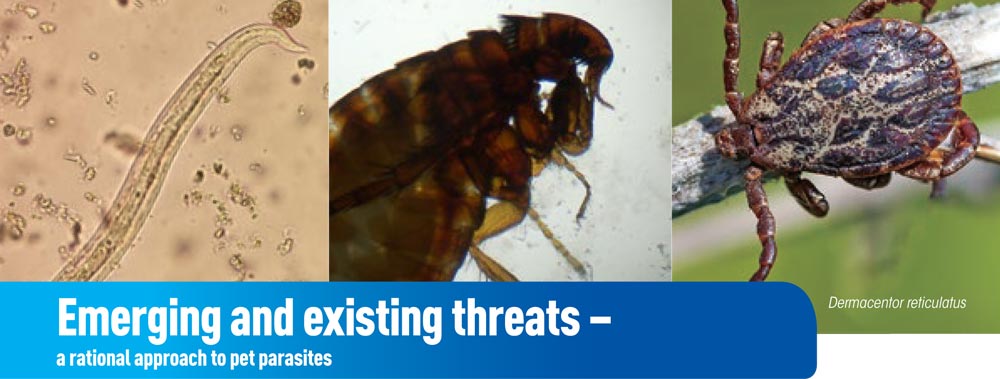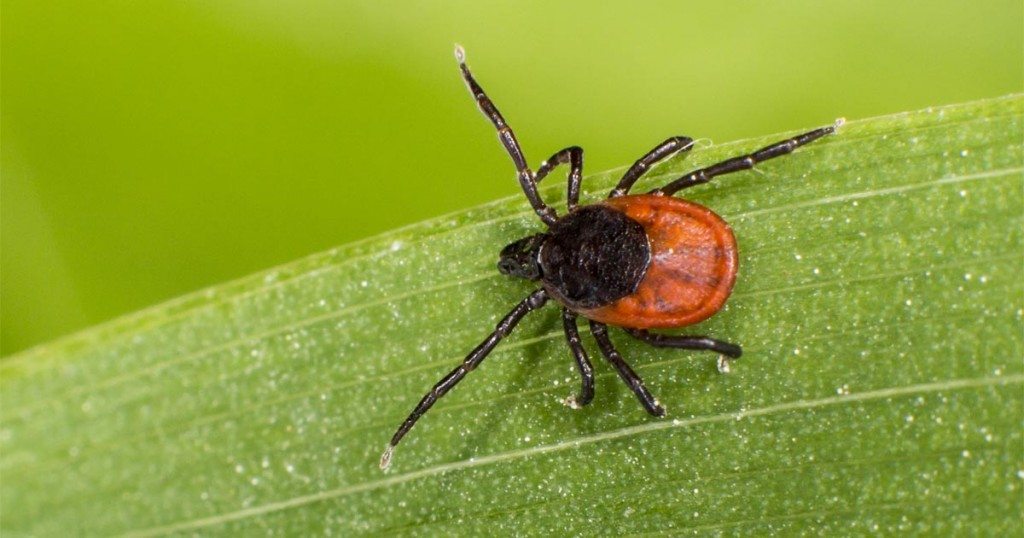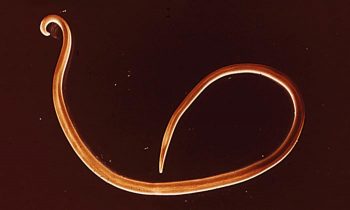1 Jun 2017
Parasitologist Ian Wright discusses the evolving parasite risks facing dogs, including the growing threat of lungworm and ticks.

Dermacentor marginatus

Dermacentor image: Starover Sibiriak/Shutterstock.com
Veterinary surgeon, co-owner of the Mount Veterinary Practice.
Independent parasitologist and head of ESCCAP UK & Ireland.*
Cats and dogs are exposed to a wide range of parasites, which may cause significant disease or present zoonotic risks to owners. The parasite threat is evolving as new risks emerge and others increase in distribution. Ticks and lungworm are causing increasing concern, but fleas and Toxocara are ubiquitous and exposure cannot be avoided.
It is the role of veterinary professionals to consider the risks that parasites pose and the control options available, and to give clear recommendations to the client. This article considers which parasites are endemic in the UK and may require preventative treatment, as well as factors to consider when forming bespoke parasite control programmes for clients’ pets.
Angiostrongylus vasorum is endemic and increasingly reported throughout the UK – with prevalence in foxes rising from 7% in 2005 (Morgan et al, 2008) to 18% in 2014 (Taylor et al, 2016). All regions report increased cases, but the distribution tends to be highly focal, especially in the North, with areas of high prevalence bordering areas where infection may be absent.

Lungworm is transmitted through the ingestion of slugs and snails and is capable of causing a range of disease syndromes in dogs. The most common clinical presentation in dogs is mild to moderate pulmonary signs. The most significant of these are coughs (either productive or unproductive) and dyspnoea, with or without tachypnoea.
A less common but more severe consequence of infection is a varying degree of coagulopathy (Morgan et al, 2005). The mechanism of this aspect of infection is still poorly understood but can lead to potentially life-threatening signs, including anaemia, haematomas, neuropathies, increased and prolonged post-operative bleeding and post-traumatic haemorrhage.
Cardiac signs are relatively rare, with pulmonary hypertension occurring in less than 5% of dogs infected with A.vasorum in primary practice (Koch & Willesen, 2009). Although less common, these more severe signs can occur even if the parasite is present in low numbers.
Routine preventative treatment should be considered in dogs at risk of exposure. Known consumption of slugs and snails, or eating grass that may contain them, increases the risk of infection. L3 larvae can be found in slime trails and can survive in water for several weeks, although the significance of this in the field is unknown. If the pet dog’s behaviour has led it to become infected in the past, this history of lungworm infection also increases the risk of another lungworm infection as there is no lasting protective immunity.
Knowledge of local cases, use of case distribution maps such as the one compiled by Idexx, and screening of suspected cases will help to build a picture of whether A.vasorum is prevalent in a particular location. AngioDetect™ (Idexx Laboratories) patient-side antigen detection from blood samples has allowed rapid, affordable screening of dogs with relevant clinical signs such as coughing, coagulopathy or neuropathies.
The risk of exposure to ticks in the UK has increased, with a milder climate allowing feeding throughout much of the year (Smith et al, 2011). A recent study showed that one in three dogs were found to be host to ticks (Abdullah et al, 2016). The ticks’ small size, especially in the larval and nymph stages, can make them hard for owners to spot.
Lyme disease in dogs caused by Borrelia spp. may lead to polyarthritis as well as renal and, less commonly, cardiac complications. 2.37% of ticks on UK dogs have been found to be carrying Borrelia spp. (Abdullah et al, 2016). Although it is unknown how this is translating into canine disease, the reported annual incidence of Lyme disease in the UK human population is increasing.

In addition to the risk of Lyme disease, an endemic focus of Babesia canis has established in Essex.
This parasite causes immune mediated haemolytic anaemia and can be fatal if not treated quickly. The parasite has already spread from its original focus in Harlow, with new cases now being reported in Romford. The focal nature of the Dermacentor vector distribution means that predicting future spread will be difficult.
No preventative treatment for ticks is 100% effective, but the use of a drug that rapidly kills ticks, such as an isoxazoline (NexGard Spectra™, Bravecto, Simparica), or repellents such as pyrethroids, will reduce the risk of disease transmission.
Factors to consider when deciding whether pets need preventative tick treatment include geographical location and a history of tick exposure. The time spent walking in areas of potential exposure; the density of Ixodes spp. ticks in the areas being walked in and prevalence of Lyme disease in those ticks are important indicators of risk. Therefore, tick prophylaxis should be advised for dogs walking in areas shared by ruminants and deer, and in areas of tall grass, bracken and undergrowth, where potential for exposure is high.
Although ‘hotspots’ for Lyme disease are recognised in human infection, it is unknown if increased reporting plays a part in these areas. Areas of high tick densities are recognised, however, and have been highlighted in recent UK distribution maps (Abdullah et al, 2016). Dogs with outdoor access to public areas living in or visiting Essex should currently be recommended routine tick preventative treatment.
If pets have been exposed to ticks in the past it suggests their lifestyle exposes them to potential infestation. Therefore, recommendation of a suitable tick prophylactic product will reduce infestation and disease transmission in the future. This recommendation should also extend to clients intending to travel outside the UK with their dogs.
Successive mild winters and wet, warm summers have favoured proliferation of cat fleas in the UK, with increased prevalence and numbers of fleas per pet. In addition, central heating allows environmental stages of the fl ea life cycle to persist all year round in the home. This combination of factors leads to increased fl ea challenge, and any break in flea treatment on any pets in a household will allow fleas to propagate and infestation to continue.
Cat fleas are a cause of human irritation and revulsion. Fleas may also cause fl ea allergic dermatitis in susceptible pets and anaemia in heavy infestations, and act as vectors for a variety of infections including Bartonella spp. (cause of cat scratch disease), Rickettsia felis (cause of spotted fever) and Haemoplasma spp. (cause of feline infectious anaemia).
Approximately 3.5–34% of adult domestic dogs and 8–76% of adult domestic cats will shed Toxocara eggs at any one time if left untreated (Overgaauw & Van Knappen, 2013). The eggs when first shed are unembryonated and not infective.
Progression to the infective embryonated L3 stage is required for infection, but after 3–7 weeks, once embryonated, they represent a zoonotic risk that can lead to debilitation, visceral pain, blindness and increased risks of chronic conditions such as asthma, epilepsy and dermatitis if ingested (Buijs et al, 1997; Pinelli et al, 2008; Quattrocchi G et al, 2012).

It has been demonstrated that use of an effective anthelmintic every three months significantly reduces Toxocara spp. ova shedding (Wright & Wolfe, 2007), but the pre-patent period of the parasite is 30 days and therefore monthly treatment with a licensed product is required to reduce egg shedding by 90% or more.
Predation of paratenic hosts or the feeding of unprocessed raw meat or offal will increase the risk of patent Toxocara spp. Infection in pets, and young children, is over-represented for toxocariasis.
Cats and dogs living in households with children or immune-suppressed individuals should be dewormed monthly to reduce Toxocara spp. ova output.
Although fresh faeces do not pose a direct risk, if pets are not dewormed monthly there is a risk infective ova will build up in gardens. It has also been demonstrated that Toxocara canis ova can embryonate in the coats of dogs (Wolfe and Wright, 2003).
Treating four times a year can therefore be viewed as deworming “for the greater good”, but monthly deworming mitigates risk in the immediate environment over time and should be considered when making a parasite-control recommendation for family pets.
Cats and dogs with flea infestations, on raw diets or exhibiting predatory behaviour may pick up large tapeworm burdens, and routine deworming for tapeworm, plus flea treatment, should be included as part of the recommended parasite-control protocol for these animals. Those in endemic areas need to consider E.granulosus, which is zoonotic, with hydatid cysts developing in the bone, liver, central nervous system and heart. Potential spread of E.granulosus through abattoirs means that dogs may be exposed outside of traditional endemic areas if fed raw offal or if allowed access to sheep and cattle carcasses.
As well as considering the parasites that the individual pet needs to be treated for and the frequency of treatment, it can be useful to consider factors affecting compliance, such as the frequency of swimming or bathing the pet, and difficulties owners may experience in administering products.
It is the role of veterinary professionals to assess the needs of clients and their pets and make specific recommendations for them. This recommendation, and their means of reaching it, should be consistent throughout a practice to avoid owner confusion and disenfranchisement. Simple algorithms starting with Toxocara and flea prevention, and then adding on additional parasite requirements to reflect the challenge from evolving parasites, can be used to reach these conclusions.
*About ESCCAP UK & Ireland.
The European Scientific Counsel for Companion Animal Parasites (ESCCAP) was formed in 2005. It is an independent not-for-profit organisation, comprising a group of eminent veterinarians across Europe, all with recognised expertise in the field of parasitology. ESCCAP is dedicated to providing access to clear and constructive information for veterinarians and pet owners with the aim of strengthening the animal–human bond. It works to provide the knowledge essential to help eradicate parasites in pets, and the objective is to have a Europe where parasites are no longer a health issue for pets or humans.
ESCCAP UK & Ireland brings together the UK and Irish national associations of ESCCAP to form a group consisting of some of the leading experts in the field of veterinary parasitology. ESCCAP UK & Ireland works with pet owners and veterinary/animal care professionals to raise awareness of the threat from parasites and to provide relevant information and advice for the UK and Ireland.
